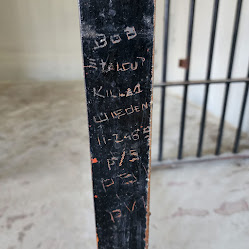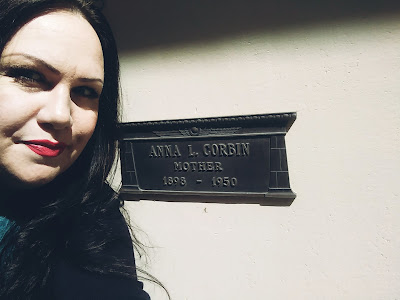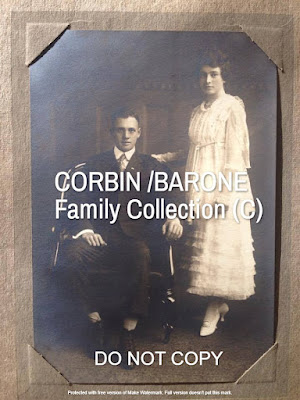Nearing the eve of the anniversary of Joseph Howe's passing at the Preston School of Industry, I decided I wanted to know more about this young man in order to remember him this year.
You see, when I first wrote my initial book and blogs on Preston's history, there weren't a lot of records readily available for searching online. Joseph's Preston record was not accessible to me at the time either, as I couldn't find it at the State Archives when I went there to search, and his official death record literally just stated that he died at Preston of "Tuberculosis" on December 11, 1913.Not much more was known about Joseph up until that point. So, when I included his name in my chapter of the boys who are buried at the cemetery at Preston, I only had his name, his date of birth and date of death. No photos, no information about his life. Nothing. I wanted to change that, so I decided to reinvestigate his story with fresh eyes.
Today, we will take a trip back in time to go over the life of Joseph Howe and I will show you how it appears the odds were stacked against him from the start. I want us to remember Joseph, not just as two dates and a dash on a weather beaten wooden headstone in a forgotten cemetery, but as a young man, flesh and blood who lived and breathed and walked those hallways at Preston Castle, if even for just a short time in his brief life.
Joseph Howe was actually born on October 20, 1895, not 1897, as his marker reads. According to the 1900 Census, which was taken in June, it states he was only 4 years old, which would be the right age, as he would turn 5 in October of that same year. At the time, Joseph is living with his mother, Ada Stella Wilkin Howe, his uncle, and his four sisters at his maternal grandmother's home in Red Bluff, Tehama County, California.
I am not sure where his father, Washington Lincoln Howe was at the time but it appears the couple reunited shortly thereafter, as Ada would have four more children with her husband, making their brood a grand total of nine children. The 1910 census for Phoenix, Jackson County, Oregon, showed the entire family together with Washington as the head of household, working "odd jobs."
Unfortunately, the family appears to have been very poor, and I believe they moved back to California sometime after the 1910 census, or at least the kids and Alma did. Joseph appears to have been born with some sort of mental disability, as he was sent around July of 1911, to the "Home for the Care and Training of Feeble Minded Children." This hospital or facility was meant to help children with mental disabilities. It was best known as the Sonoma State Hospital and later the Sonoma Developmental Center. Sadly, this place wasn't a very good hospital. This location was known for their "Eugenics" program in the early 1900's and between 1909 and 1952, a total of 5,530 males and females were involuntarily put through sterilization procedures, which according to records was more than any other state hospital in the nation.
It doesn't appear that Joseph stayed there too long, but what happened during the time he was at that facility is unknown. One can only imagine!
According to the Chico Record, the hospital in Sonoma didn't have a lot of room for their patients so they eventually released him back to his family in Chico. It was during this time period that his mother passed away, on January 16, 1912.
Ada Howe, Joseph's mother, had been ill for sometime, and according to the death notice in the local newspaper she was suffering from an incurable illness, which caused an abscess on the knee which "weakened her condition" and "made it impossible to long survive." I did a little research on this subject, and I have come to the conclusion that Ada more than likely had been suffering from Pulmonary Tuberculosis, and she developed a secondary infection, called a "cold abscess" which can develop when the Mycobacterium tuberculosis bacteria travels through the bloodstream into the extremities.
I believe that Joseph contracted Tuberculosis from contact in the household, as two of his other sisters ended up with the same disease and died from it as well. His older sister, Alma passed away from the illness in March of 1913, and another sister, Irma passed away in 1917 from the same disease. During this time period, Tuberculosis was a widespread health crisis, and one in seven deaths were the result of this infection, especially in poor households.
The December 18, 1912 edition of the Chico Record stated that Joseph, who was then 16 years old, was caught with 14 year old, Ival Scalf, stealing a horse and buggy from J.L. Crawford at the corner of Salem and Second Street in Chico. This location was only one block over and four blocks northwest from where Joseph had been living at 220 W. 6th Street.
Judge John C. Gray, presiding over the juvenile court committed the boys to Preston on December 17th, just the day prior to the article's release.Constable McEldowney and probation officer J.A. Glenn brought the boys to Preston. The problem was, where was the record of his committment at Preston?
I searched my ward index that I had compiled back in 2014, of all wards committed from the time the school opened in 1894 to 1914. I could find no trace of Joseph. I began to feel uneasy and perplexed. How could someone who we know was sent to Preston, especially since he passed away on the property and was buried in its own cemetery, just simply have no record of having been there on the juvenile record list?
I went back to the California Youth Authority records via the State Archives and again, no Joseph Howe was listed. How could this young man simply just slip through the cracks at Preston?
Well, after diligent research and cross referencing I think I may have found the answer. I decided to double check his accomplice's committment records at Preston, Ivan Scalf, and sure enough, he was in my index under ward # 1986, sent to Preston in 1912. Just underneath his name is Joseph Herve, ward # 1987, sent to Preston the same time in 1912. It is my belief that the people who entered the records into the CYA database misspelled Joseph's last name to Herve instead of Howe. This has to be the answer for his missing record at the school.
Sadly, Joseph would only spend one year at the school before succumbing to the same Tuberculosis that took the life of his mother and sister before him. I cannot even imagine what he must have been feeling or thinking, laying there in a sick bed, suffering from such a horrific illness such as that, and knowing that he was not going to get better; That he would never be able to get up and walk out of that building and live life, a life he never had a chance to even know. Instead, he passed away from his illness there at Preston, surrounded by strangers. It is heartbreaking to imagine.
Due to the fact that his mother was gone, and I believe his father just wasn't around, Joseph's remains were buried at the Preston Cemetery out back on the property. You see, back then the cemetery wasn't originally meant to be a permanent place, but instead a spot for the unclaimed boys in the event their parents did not have the money to take them to be buried elsewhere, or to keep them safe until the families were able to disenter and reinter them some other place. In this case, Joseph Howe would remain there in that spot at the Preston cemetery with it's castle looming over the horizon into the near distance.
Although there are no photographs of Joseph in existence that I know of, I tried my best to use modern computer technology to provide a possible idea of what Joseph may have looked like, based on the likeness of his brother, whom I was able to obtain a photo of.
 |
| First computer AI speculative sibling image based on a photograph of Joseph's brother. |
 |
| 2nd AI speculative sibling image (created more as a painting rather than a photograph) based on a photo of Joseph's brother, as a possible sibling likeness. |
By using this AI program using "speculative sibling imagery" this enables us to try to imagine what he may have looked like, if he did in fact look like his brother (who shared the same mother and father).
As you can see the two images I came up with look a little different, so we may never fully know what Joseph looked like unless someone, somewhere has a photograph of him. Until then, we must leave it up to our imaginations I suppose. I just wanted so badly to give a face to his name, so that we can remember him and so that we can honor his memory.
This week will be 112 years since Joseph left this earth. I didn't want his story to remain untold any longer. English writer Amelia B. Edwards once wrote:
“We all die twice.... The first time is when we simply cease to be; the second, when we are forgotten.” -- Amelia B. Edwards (1863)
With that in mind, let us honor Joseph's memory by learning his story and retelling it for years to come, so that he is never forgotten again. After all, everyone deserves to have their life remembered, large or small, rich or poor. In the end, we all end up in the same place, but that doesn't mean that our story should end there.
(Copyright 2025- jaimerubiowriter.com)













.jpg)











